Analysis of the Expansion Characteristics and Carrying Capacity of Oasis Farmland in Northwestern China in Recent 40 Years
Abstract
1. Introduction
2. Materials and Methods
2.1. Study Area
2.2. Data Sources
2.3. Methods
2.3.1. Water and Energy Balance Model for Oasis-Carrying Capacity
2.3.2. The Ground Water Storage Anomaly (GWSA) from GRACE and GLDAS
2.3.3. Linear Programming for Planting Structure Optimization
3. Results
3.1. Changes in the Area of 5TOGs and Their Farmlands in the Past 50 Years
3.1.1. 5TOGs and Their Catchment Areas
3.1.2. Changes in the Area of the 5TOGs and Their Oasis Farmland
3.1.3. Land Use/Cover Change (LUCC) Analysis of 5TOGs
3.2. Evaluation of the Carrying Capacity and Its Suitable Scale in 5TOGs
3.2.1. Carrying Capacity Dynamics of the 5TOGs
3.2.2. Change in the Ground Water Storage of the 5TOGs
3.2.3. Suitable Scales of the 5TOGs
3.3. Optimization of Planting Structure for 5TOGs under Their Suitable Scales
3.3.1. Current Planting Structures of the 5TOGs
3.3.2. Optimized Planting Structures of the 5TOGs under the Suitable Scales
4. Discussion
4.1. Optimization of Planting Structure for 5TOGs under Their Suitable Scales
4.2. Relationship between Results of Heat-Water Balance Model and GWSA of GREACE
4.3. The Implications of Optimizing the Planting Structure
5. Conclusions
Author Contributions
Funding
Data Availability Statement
Conflicts of Interest
Appendix A
| Aksu River Oasis Group | Hotan River Oasis Group | Yarkand River Oasis Group | Tianshan Mountain Northern Slope Rivers Oasis Group | Heihe River Oasis Group | |||||||||||||||||||||||
|---|---|---|---|---|---|---|---|---|---|---|---|---|---|---|---|---|---|---|---|---|---|---|---|---|---|---|---|
| Crops | Area | Yield | Unit Price | Unit Yield | Irrigation Quota | Crops | Area | Yield | Unit Price | Unit Yield | Irrigation Quota | Crops | Area | Yield (ton) | Unit Price | Unit Yield | Irrigation Quota | Crops | Area | Yield | Unit Price | Unit Yield | Crops | Area | Yield | Unit Price | Unit Yield |
| - | (mu) | (ton) | (yuan/ton) | (kg/mu) | (ton/mu) | (mu) | (ton) | (yuan/ton) | (kg/mu) | (ton/mu) | (mu) | (ton) | (yuan/ton) | (kg/mu) | (ton/mu) | (mu) | (ton) | (yuan/ton) | (kg/mu) | (mu) | (ton) | (yuan/ton) | (kg/mu) | ||||
| Cotton | 4,219,852 | 1,596,032 | 7500 | 378.22 | 430 | Wheat | 972,550 | 355,896 | 2300 | 439.13 | 270 | Cotton | 4,086,914 | 501,611.45 | 7500 | 421.33 | 305 | Cotton | 2,432,583 | 986,571 | 7500 | 426.05 | Maize | 1,541,800 | 788,558 | 1702.5 | 511.45 |
| Jujubes | 1,496,823 | 1,506,277 | 3274 | 1006.32 | 485 | Maize | 724,227 | 298,990 | 2100 | 495.41 | 255 | Wheat | 2,014,787 | 809,829.85 | 2407 | 462 | 245 | Vegetables | 266,125 | 1,258,759 | 1463.75 | 3511.99 | Vegetables | 414,800 | 1,292,670 | 1463.75 | 3116.37 |
| Walnuts | 1,546,525 | 327,471 | 9888 | 211.75 | 485 | Walnuts | 723,240 | 153,146 | 9888 | 211.75 | 365 | Maize | 1,862,267 | 943,324.6 | 2229 | 537 | 252 | Maize | 913,195 | 611,766 | 1702.5 | 669.92 | Wheat | 518,200 | 226,876 | 2182.5 | 437.82 |
| Wheat | 898,154 | 412,894 | 2183 | 459.71 | 375 | Jujubes | 529,845 | 83,385 | 4000 | 188.85 | 365 | Vegetables | 420,103 | 1,463,734 | 2824 | 3334 | 295 | Melonss | 98,090 | 40,2808 | 968.75 | 3504.78 | Tubers | 334,000 | 185,393.7 | 1050 | 555.07 |
| Maize | 676,565 | 421,273 | 1703 | 622.66 | 365 | Cotton | 238,859 | 21,934 | 7500 | 293.85 | 310 | Melonss | 438,854 | 1,264,976 | 2162 | 3344 | 245 | Grapes | 262,615 | 32,2918 | 1800 | 1229.63 | Herbs | 285,900 | 107,139.9 | 32,000 | 374.75 |
| Apples | 291,039 | 652,952 | 1838 | 2243.52 | 485 | Vegetables | 119,827 | 192,389 | 1500 | 1926.67 | 370 | Jujubes | 352,107 | 698,311.84 | 8334 | 211.75 | 440 | Wheat | 614,109 | 18,9781 | 2182.5 | 309 | Barley | 204,100 | 87,880.8 | 2300 | 430.58 |
| others | 330,451 | 521,203 | - | 1577.25 | 340 | Grapes | 113,925 | 127,794 | 2000 | 1346.09 | 365 | Walnuts | 22,519 | 454,561.34 | 9887.5 | 211.75 | 440 | Others | 631,426 | 91,324 | 1500 | 124.5 | Oil crops | 119,400 | 25,392.2 | 4766.667 | 212.66 |
| Vegetables | 272,552 | 675,319 | 1464 | 2477.76 | 420 | Melons | 51,040 | 97,456 | 969 | 2291.29 | 295 | Beans | 283,962 | 37,715 | - | 377 | 245 | Beets | 59,767 | 257,831 | 658.96 | 4317.26 | Grapes | 33,500 | 30,448.2 | 1800 | 908.9 |
| Pears | 189,916 | 469,742 | 2163 | 2473.42 | 485 | Apricots | 46,965 | 34,944 | 1000 | 892.85 | 515 | Tubers | 75,605 | 221,410 | - | 709 | 255 | Apples | 43,864 | 31,573 | 1837.5 | 719.79 | Beets | 21,400 | 51,341.3 | 658.96 | 2399.13 |
| Melons | 120,641 | 198,587 | 969 | 1646.1 | 340 | Oil crops | 37,401 | 3957 | 6412 | 126.96 | 270 | Apples | 71,149 | 192,346.88 | - | - | 440 | Tubers | 9222 | 37,671 | 1050 | 3977.09 | Pears | 28,400 | 11,386.8 | 2162.5 | 400.94 |
| Apricots | 77,273 | 163,279 | 1300 | 2113.01 | 485 | Apples | 14,250 | 10,787 | 1500 | 908.38 | 515 | Pears | 67,138 | 81,901.46 | - | - | 440 | Oil crops | 68,755 | 11,995 | 4766.67 | 174.47 | Jujubes | 17,600 | 9800.7 | 3274.125 | 556.86 |
| Beets | 30,750 | 129,668 | 659 | 4216.85 | 380 | Peaches | 8220 | 4116 | 7000 | 600.88 | 515 | Oil crops | 86,022 | 11,337 | - | 313 | 255 | Peaches | 14,835 | 23,592 | 1800 | 1590.29 | Apples | 4400 | 6818.5 | 1837.5 | 1549.66 |
| Oil crops | 52,951 | 8752 | 4767 | 165.28 | 360 | Pears | 1110 | 1152 | 1400 | 1245.41 | 515 | Peaches | 4278 | 32,518.64 | - | - | 440 | Matrimony vine | 18,300 | 3062 | 1800 | 163.75 | |||||
| Grapes | 28,772 | 64,009 | 1800 | 2224.7 | 445 | Grapes | 8953 | 21,368.67 | - | - | 340 | Jujube | 7481 | 1430 | 3274.13 | 191.15 | |||||||||||
| Tubers | 18,031 | 34,207 | 1050 | 1897.12 | 360 | Beans | 4000 | 265 | 2500 | 66.16 | |||||||||||||||||
References
- Zhang, Z.; Xu, E.; Zhang, H. Complex network and redundancy analysis of spatial–temporal dynamic changes and driving forces behind changes in oases within the Tarim Basin in northwestern China. Catena 2021, 201, 105216. [Google Scholar] [CrossRef]
- Wang, Y.; Li, Y.; Xiao, D. Catchment scale spatial variability of soil salt content in agricultural oasis, Northwest China. Environ. Geol. 2008, 56, 439–446. [Google Scholar] [CrossRef]
- Li, X.; Yang, K.; Zhou, Y. Progress in the study of oasis-desert interactions. Agric. Forest Meteorol. 2016, 230–231, 1–7. [Google Scholar] [CrossRef]
- Gui, D.; Wu, Y.; Zeng, F.; Lei, J.; Liu, G. Study on the oasification process and its effects on soil particle distribution in the south rim of the Tarim Basin, China in recent 30 years. Procedia Environ. Sci. 2011, 3, 69–74. [Google Scholar] [CrossRef][Green Version]
- Xue, J.; Gui, D.; Lei, J.; Sun, H.; Zeng, F.; Mao, D.; Jin, Q.; Liu, Y. Oasification: An unable evasive process in fighting against desertification for the sustainable development of arid and semiarid regions of China. Catena 2019, 179, 197–209. [Google Scholar] [CrossRef]
- Zhang, X.; Jin, X.; Bai, X.; Jiang, Y.; He, C. Impacts of water resource planning on regional water consumption pattern: A case study in Dunhuang Oasis, China. J. Arid Land 2019, 11, 713–728. [Google Scholar] [CrossRef]
- Yang, G.; Li, F.; Chen, D.; He, X.; Xue, L.; Long, A. Assessment of changes in oasis scale and water management in the arid Manas River Basin, north western China. Sci. Total Environ. 2019, 691, 506–515. [Google Scholar] [CrossRef] [PubMed]
- Xie, Y.; Zhao, H.; Wang, G. Spatio-temporal changes in oases in the Heihe River Basin of China: 1963–2013. Écoscience 2015, 22, 33–46. [Google Scholar] [CrossRef]
- Bie, Q.; Xie, Y. The constraints and driving forces of oasis development in arid region: A case study of the Hexi Corridor in northwest China. Sci. Rep. 2020, 10, 1–11. [Google Scholar] [CrossRef] [PubMed]
- Liu, X.; Shen, Y. Quantification of the impacts of climate change and human agricultural activities on oasis water requirements in an arid region: A case study of the Heihe River basin, China. Earth Syst. Dyn. 2018, 9, 211–225. [Google Scholar] [CrossRef]
- He, P.; Sun, Z.; Han, Z.; Dong, Y.; Liu, H.; Meng, X.; Ma, J. Dynamic characteristics and driving factors of vegetation greenness under changing environments in Xinjiang, China. Environ. Sci. Pollut. Res. 2021, 28, 42516–42532. [Google Scholar] [CrossRef]
- Xu, E.; Zhang, H.; Xu, Y. Exploring land reclamation history: Soil organic carbon sequestration due to dramatic oasis agriculture expansion in arid region of Northwest China. Ecol. Indic. 2020, 108, 105746. [Google Scholar] [CrossRef]
- Zhang, S.; Chen, F.; Chen, J.; Wang, J.; Li, S.; Long, A. A cultivated area forecasting approach in artificial oases under climate change and human activities. J. Arid Land 2019, 11, 400–418. [Google Scholar] [CrossRef]
- Li, H.; Zeng, F.; Gui, D.; Lei, J. Characteristics of Soil Environment Variation in Oasis–Desert Ecotone in the Process of Oasis Growth. In Proceedings of the International Conference on Computer and Computing Technologies in Agriculture, Nanchang, China, 22–25 October 2010; pp. 321–334. [Google Scholar]
- Liu, Y.; Xue, J.; Gui, D.; Lei, J.; Sun, H.; Lv, G.; Zhang, Z. Agricultural oasis expansion and its impact on oasis landscape patterns in the southern margin of Tarim basin, Northwest China. Sustainability 2018, 10, 1957. [Google Scholar] [CrossRef]
- Meng, L.; Chen, Y.; Li, W.; Zhao, R. Fuzzy comprehensive evaluation model for water resources carrying capacity in Tarim River Basin, Xinjiang, China. Chin. Geogr. Sci. 2009, 19, 89–95. [Google Scholar] [CrossRef]
- Han, Y.; Jia, S. An Assessment of the Water Resources Carrying Capacity in Xinjiang. Water 2022, 14, 1510. [Google Scholar] [CrossRef]
- Zhi, X.; Anfuding, G.; Yang, G.; Gong, P.; Wang, C.; Li, Y.; Li, X.; Li, P.; Liu, C.; Qiao, C. Evaluation of the Water Resource Carrying Capacity on the North Slope of the Tianshan Mountains, Northwest China. Sustainability 2022, 14, 1905. [Google Scholar] [CrossRef]
- Wan, L.; Xia, J.; Hong, S.; Bu, H.; Ning, L.; Chen, J. Decadal climate variability and vulnerability of water resources in arid regions of Northwest China. Environ. Earth Sci. 2015, 73, 6539–6552. [Google Scholar] [CrossRef]
- Wang, J.; Zhang, F.; Jim, C.-Y.; Chan, N.W.; Johnson, V.C.; Liu, C.; Duan, P.; Bahtebay, J. Spatio-temporal variations and drivers of ecological carrying capacity in a typical mountain-oasis-desert area, Xinjiang, China. Ecol. Eng. 2022, 180, 106672. [Google Scholar] [CrossRef]
- Ye, Z.; Fu, A.; Zhang, S.; Yang, Y. Suitable scale of an oasis in different scenarios in an arid region of china: A case study of the ejina oasis. Sustainability 2020, 12, 2583. [Google Scholar] [CrossRef]
- Hao, L.; Su, X.; Singh, V.P.; Zhang, L.; Zhang, G. Suitable oasis and cultivated land scales in arid regions based on ecological health. Ecol. Indic. 2019, 102, 33–42. [Google Scholar] [CrossRef]
- Guo, H.; Ling, H.; Xu, H.; Guo, B. Study of suitable oasis scales based on water resource availability in an arid region of China: A case study of Hotan River Basin. Environ. Earth Sci. 2016, 75, 1–14. [Google Scholar] [CrossRef]
- Ling, H.; Xu, H.; Fu, J.; Fan, Z.; Xu, X. Suitable oasis scale in a typical continental river basin in an arid region of China: A case study of the Manas River Basin. Quat. Int. 2013, 286, 116–125. [Google Scholar] [CrossRef]
- Han, Z.; Zhang, B.; Yang, L.; He, C. Assessment of the impact of future climate change on maize yield and water use efficiency in agro-pastoral ecotone of Northwestern China. J. Agron. Crop Sci. 2021, 207, 317–331. [Google Scholar] [CrossRef]
- Jiang, T.; Su, X.; Singh, V.P.; Zhang, G. Spatio-temporal pattern of ecological droughts and their impacts on health of vegetation in Northwestern China. J. Environ. Manag. 2022, 305, 114356. [Google Scholar] [CrossRef]
- Wang, T.; Wang, Z.; Guo, L.; Zhang, J.; Li, W.; He, H.; Zong, R.; Wang, D.; Jia, Z.; Wen, Y. Experiences and challenges of agricultural development in an artificial oasis: A review. Agric. Syst. 2021, 193, 103220. [Google Scholar] [CrossRef]
- Wang, P.; Wei, Y.; Zhong, F.; Song, X.; Wang, B.; Wang, Q. Evaluation of Agricultural Water Resources Carrying Capacity and Its Influencing Factors: A Case Study of Townships in the Arid Region of Northwest China. Agriculture 2022, 12, 700. [Google Scholar] [CrossRef]
- Gui, D.; Lei, J.; Zeng, F. Farmland management effects on the quality of surface soil during oasification in the southern rim of the Tarim Basin in Xinjiang, China. Plant Soil Environ. 2010, 56, 348–356. [Google Scholar] [CrossRef]
- Feike, T.; Mamitimin, Y.; Li, L.; Doluschitz, R. Development of agricultural land and water use and its driving forces along the Aksu and Tarim River, PR China. Environ. Earth Sci. 2015, 73, 517–531. [Google Scholar] [CrossRef]
- Zhang, D.-M.; Zhao, W.-Z.; Zhang, G.-F. Soil moisture and salt ionic composition effects on species distribution and diversity in semiarid inland saline habitats, northwestern China. Ecol. Res. 2018, 33, 505–515. [Google Scholar] [CrossRef]
- Wang, G.; Shen, Y.; Zhang, J.; Wang, S.; Mao, W. The effects of human activities on oasis climate and hydrologic environment in the Aksu River Basin, Xinjiang, China. Environ. Earth Sci. 2010, 59, 1759–1769. [Google Scholar] [CrossRef]
- Fu, A.; Li, W.; Wang, Y. Calculation of targeted eco-environmental water requirements in a dry inland river: A case study of the Yarkand River Basin, Xinjiang, China. SN Appl. Sci. 2021, 3, 680. [Google Scholar] [CrossRef]
- Gui, D.; Li, B.; Zhang, S.; Liu, Y.; Liu, C. Aksu Oasis. Digit. J. Glob. Chang. Data Repos. 2021. [Google Scholar] [CrossRef]
- Gui, D.; Li, B.; Zhang, S.; Liu, Y.; Liu, C. Yarkant Oasis. Digit. J. Glob. Chang. Data Repos. 2021. [Google Scholar] [CrossRef]
- Gui, D.; Li, B.; Zhang, S.; Liu, Y.; Liu, C. Hotan Oasis. Digit. J. Glob. Chang. Data Repos. 2020. [Google Scholar] [CrossRef]
- NASA/METI/AIST/Japan Space Systems; U.S./Japan ASTER Science Team. ASTER Global Digital Elevation Model V003. 2018. Available online: https://doi.org/10.5067/ASTER/ASTGTM (accessed on 24 March 2021).
- Editoral Commitee of Encyclopedia of Rivers and Lakes in China. Encyclopedia of Rivers and Lakes in China, Section of River Basins in Northwest Region; Volume Section of River Basins in Northwest Region; China Water & Power Press: Beijing, China, 2014. [Google Scholar]
- Xue, D.; Gui, D.; Dai, H.; Liu, Y.; Liu, Y.; Zhang, L.; Ahmed, Z. Oasis sustainability assessment in arid areas using GRACE satellite data. Environ. Monit. Assess. 2022, 194, 361. [Google Scholar] [CrossRef]
- Wang, Z.; Wang, H.; Lei, Z. Stability analysis of oasis in arid region. J. Hydraul. Eng. 2002, 5, 26–31. [Google Scholar]
- Allen, R.G.; Pereira, L.S.; Raes, D.; Smith, M. Crop Evapotranspiration-Guidelines for Computing Crop Water Requirements-FAO Irrigation and Drainage Paper 56; FAO: Rome, Italy, 1998; Volume 300, p. D05109. [Google Scholar]
- Zhang, C.; Dong, J.; Zuo, L.; Ge, Q. Tracking spatiotemporal dynamics of irrigated croplands in China from 2000 to 2019 through the synergy of remote sensing, statistics, and historical irrigation datasets. Agric. Water Manag. 2022, 263, 107458. [Google Scholar] [CrossRef]
- Fang, C.; Gao, Q.; Zhang, X.; Cheng, W. Spatiotemporal characteristics of the expansion of an urban agglomeration and its effect on the eco-environment: Case study on the northern slope of the Tianshan Mountains. Sci. China Earth Sci. 2019, 62, 1461–1472. [Google Scholar] [CrossRef]
- Airiken, M.; Zhang, F.; Chan, N.W.; Kung, H.-t. Assessment of spatial and temporal ecological environment quality under land use change of urban agglomeration in the North Slope of Tianshan, China. Environ. Sci. Pollut. Res. 2022, 29, 12282–12299. [Google Scholar] [CrossRef]
- Feng, Q.; Yang, L.; Deo, R.C.; AghaKouchak, A.; Adamowski, J.F.; Stone, R.; Yin, Z.; Liu, W.; Si, J.; Wen, X. Domino effect of climate change over two millennia in ancient China’s Hexi Corridor. Nat. Sustain. 2019, 2, 957–961. [Google Scholar] [CrossRef]
- Yang, L.; Feng, Q.; Adamowski, J.F.; Deo, R.C.; Yin, Z.; Wen, X.; Tang, X.; Wu, M. Causality of climate, food production and conflict over the last two millennia in the Hexi Corridor, China. Sci. Total Environ. 2020, 713, 136587. [Google Scholar] [CrossRef]
- Xu, Z.; Wei, H.; Fan, W.; Wang, X.; Zhang, P.; Ren, J.; Lu, N.; Gao, Z.; Dong, X.; Kong, W. Relationships between ecosystem services and human well-being changes based on carbon flow—A case study of the Manas River Basin, Xinjiang, China. Ecosyst. Serv. 2019, 37, 100934. [Google Scholar] [CrossRef]
- Wang, Y.; Shataer, R.; Xia, T.; Chang, X.; Zhen, H.; Li, Z. Evaluation on the Change Characteristics of Ecosystem Service Function in the Northern Xinjiang Based on Land Use Change. Sustainability 2021, 13, 9679. [Google Scholar] [CrossRef]
- Han, C.; Zheng, J.; Guan, J.; Yu, D.; Lu, B. Evaluating and simulating resource and environmental carrying capacity in arid and semiarid regions: A case study of Xinjiang, China. J. Clean. Prod. 2022, 338, 130646. [Google Scholar] [CrossRef]
- Maimaiti, B.; Chen, S.; Kasimu, A.; Simayi, Z.; Aierken, N. Urban spatial expansion and its impacts on ecosystem service value of typical oasis cities around Tarim Basin, northwest China. Int. J. Appl. Earth Obs. Geoinf. 2021, 104, 102554. [Google Scholar] [CrossRef]
- Wang, S.; Zhao, Q.; Pu, T. Assessment of water stress level about global glacier-covered arid areas: A case study in the Shule River Basin, northwestern China. J. Hydrol. Reg. Stud. 2021, 37, 100895. [Google Scholar] [CrossRef]
- Li, D.; Li, X.; He, X.; Yang, G.; Du, Y.; Li, X. Groundwater Dynamic Characteristics with the Ecological Threshold in the Northwest China Oasis. Sustainability 2022, 14, 5390. [Google Scholar] [CrossRef]
- Li, X.; Luo, F. A Dynamic Econometric Analysis of Urbanization and Ecological Environment in Silk Road Economic Belt. Sci. Program. 2022, 2022. [Google Scholar] [CrossRef]
- Reulier, R.; Delahaye, D.; Viel, V. Agricultural landscape evolution and structural connectivity to the river for matter flux, a multi-agents simulation approach. Catena 2019, 174, 524–535. [Google Scholar] [CrossRef]
- Eigner, A.E.; Nuppenau, E.-A. Applied spatial approach of modelling field size changes based on a consideration of farm and landscape interrelations. Agric. Syst. 2019, 176, 102648. [Google Scholar] [CrossRef]
- Wei, X.; Shen, L.; Liu, Z.; Luo, L.; Wang, J.; Chen, Y. Comparative analysis on the evolution of ecological carrying capacity between provinces during urbanization process in China. Ecol. Indic. 2020, 112, 106179. [Google Scholar] [CrossRef]
- Ariken, M.; Zhang, F.; weng Chan, N. Coupling coordination analysis and spatio-temporal heterogeneity between urbanization and eco-environment along the Silk Road Economic Belt in China. Ecol. Indic. 2021, 121, 107014. [Google Scholar] [CrossRef]
- Cheng, G.; Li, X.; Zhao, W.; Xu, Z.; Feng, Q.; Xiao, S.; Xiao, H. Integrated study of the water–ecosystem–economy in the Heihe River Basin. Natl. Sci. Rev. 2014, 1, 413–428. [Google Scholar] [CrossRef]
- De Fraiture, C.; Wichelns, D. Satisfying future water demands for agriculture. Agric. Water Manag. 2010, 97, 502–511. [Google Scholar] [CrossRef]
- Wu, Y.; Yang, G.; Tian, L.; Gu, X.; Li, X.; He, X.; Xue, L.; Li, P.; Xiao, S. Spatiotemporal variation in groundwater level within the Manas River Basin, Northwest China: Relative impacts of natural and human factors. Open Geosci. 2021, 13, 626–638. [Google Scholar] [CrossRef]
- Degani, E.; Leigh, S.G.; Barber, H.M.; Jones, H.E.; Lukac, M.; Sutton, P.; Potts, S.G. Crop rotations in a climate change scenario: Short-term effects of crop diversity on resilience and ecosystem service provision under drought. Agric. Ecosyst. Environ. 2019, 285, 106625. [Google Scholar] [CrossRef]
- Liu, G. Understanding cotton cultivation dynamics in Aksu Oases (NW China) by reconstructing change trajectories using multi-temporal Landsat and Sentinel-2 data. Geocarto Int. 2021, 37, 4406–4424. [Google Scholar] [CrossRef]
- Han, L.; Ding, J.; Wang, J.; Zhang, J.; Xie, B.; Hao, J. Monitoring Oasis Cotton Fields Expansion in Arid Zones Using the Google Earth Engine: A Case Study in the Ogan-Kucha River Oasis, Xinjiang, China. Remote Sens. 2022, 14, 225. [Google Scholar] [CrossRef]
- Fonseca, A.M.P.; Marques, C.A.; Pinto-Correia, T.; Guiomar, N.; Campbell, D.E. Emergy evaluation for decision-making in complex multifunctional farming systems. Agric. Syst. 2019, 171, 1–12. [Google Scholar] [CrossRef]

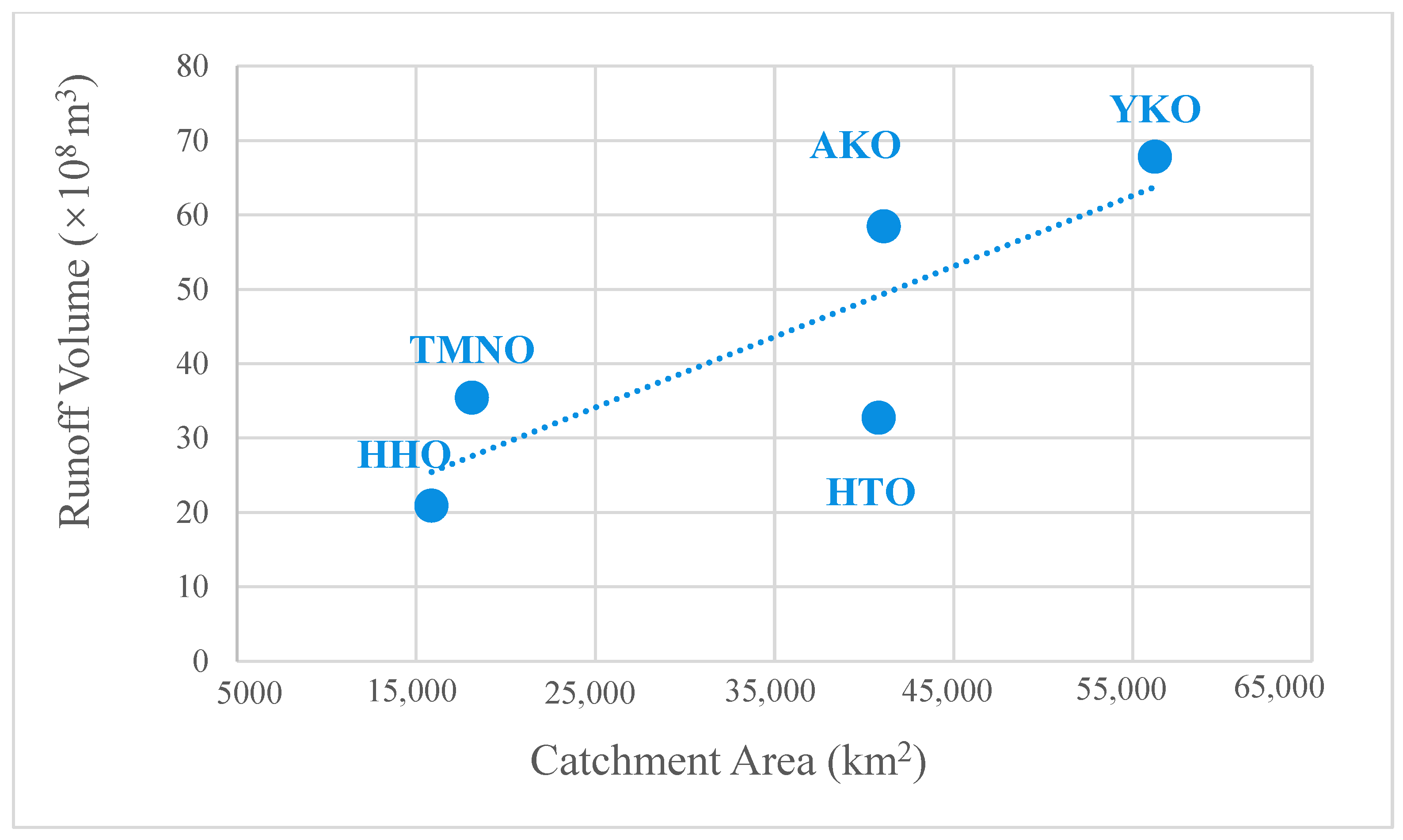

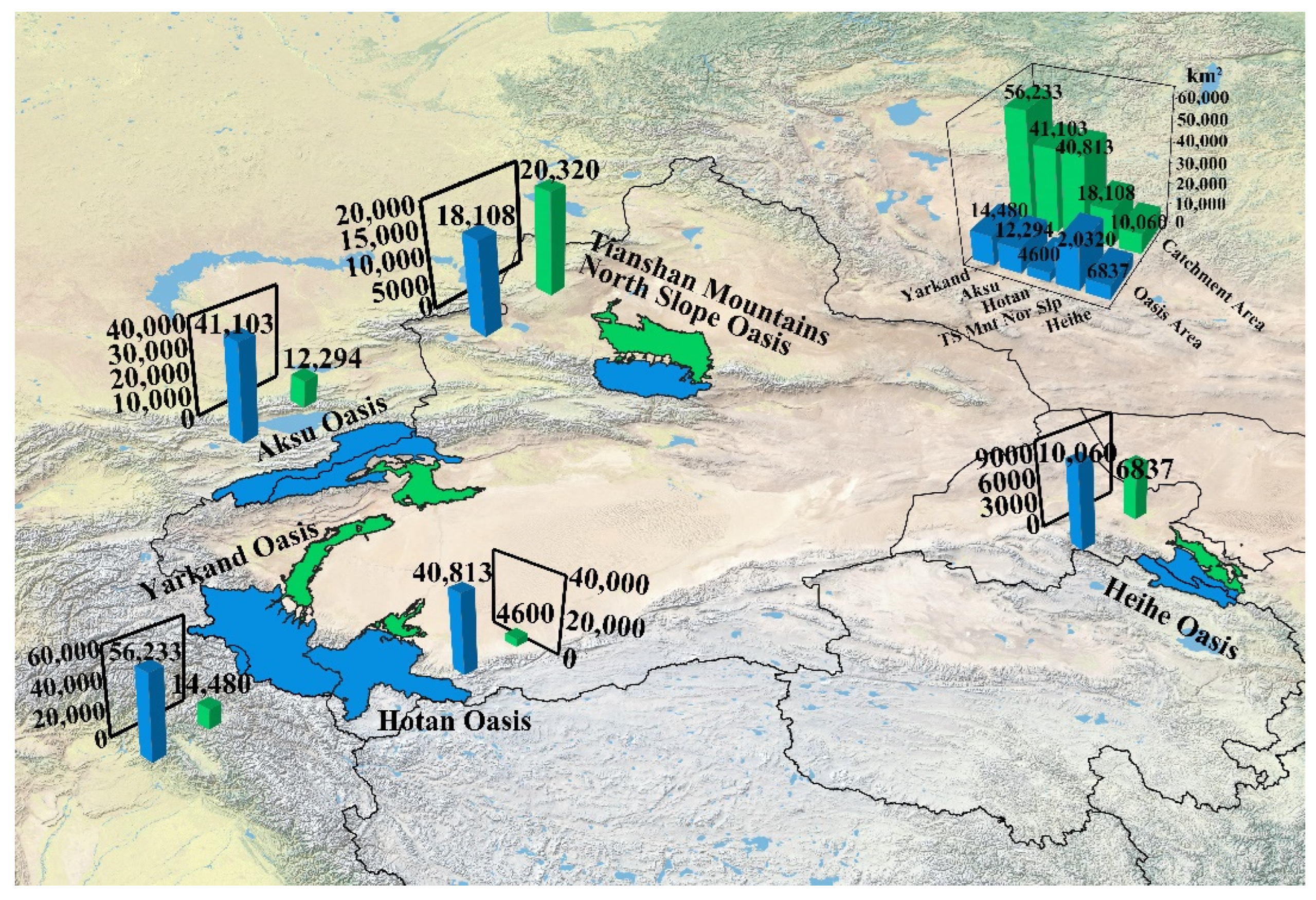


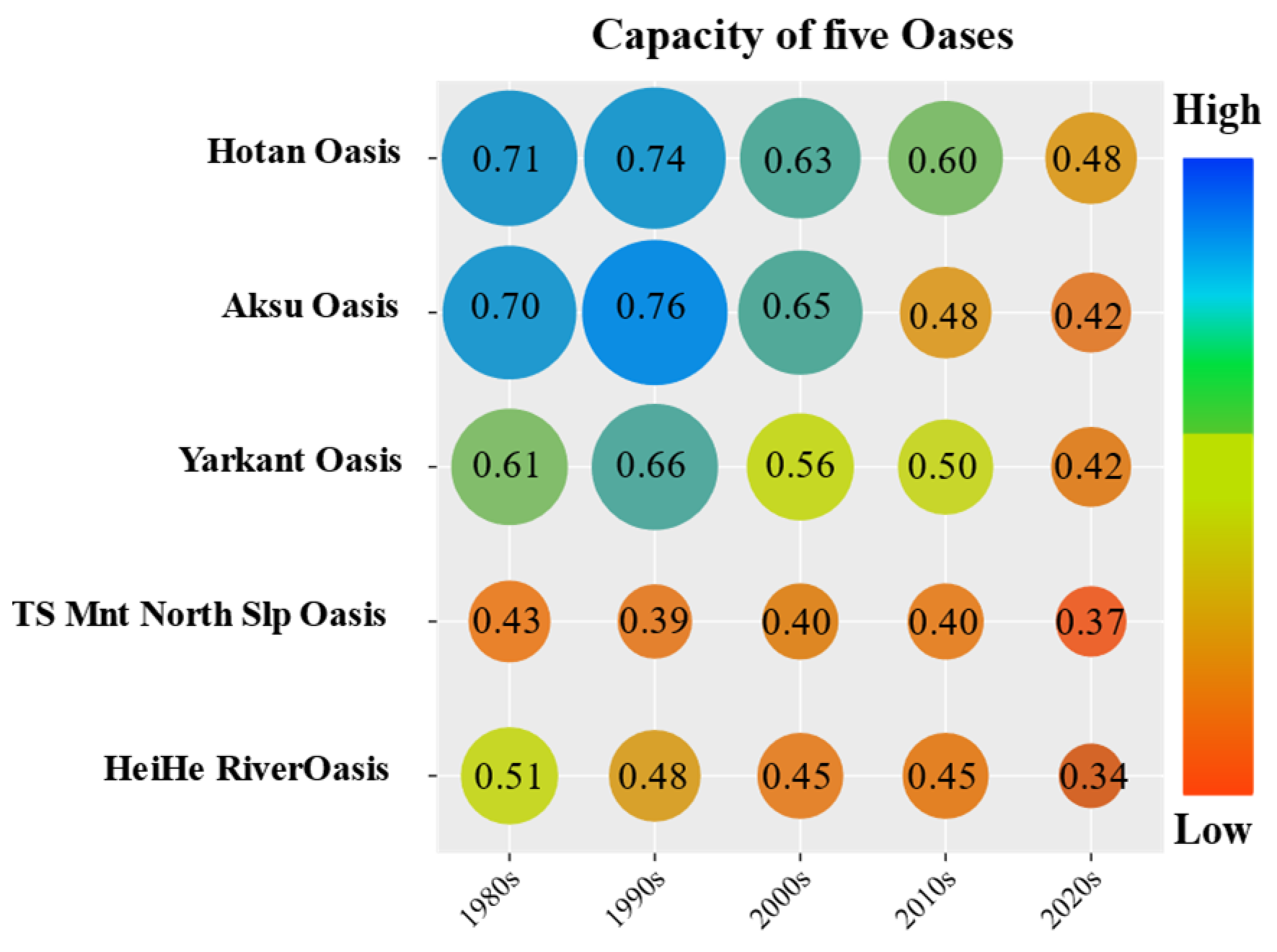
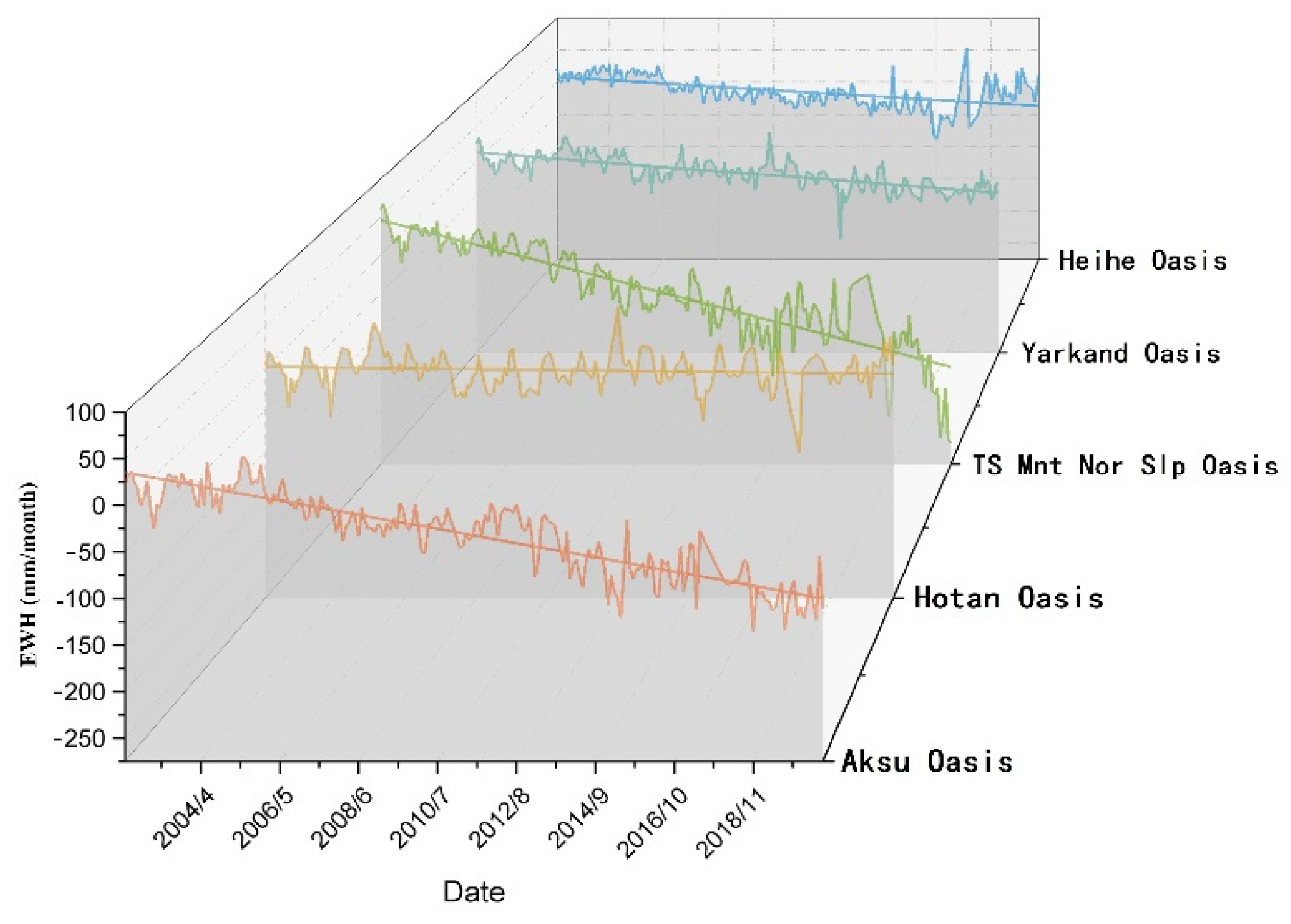
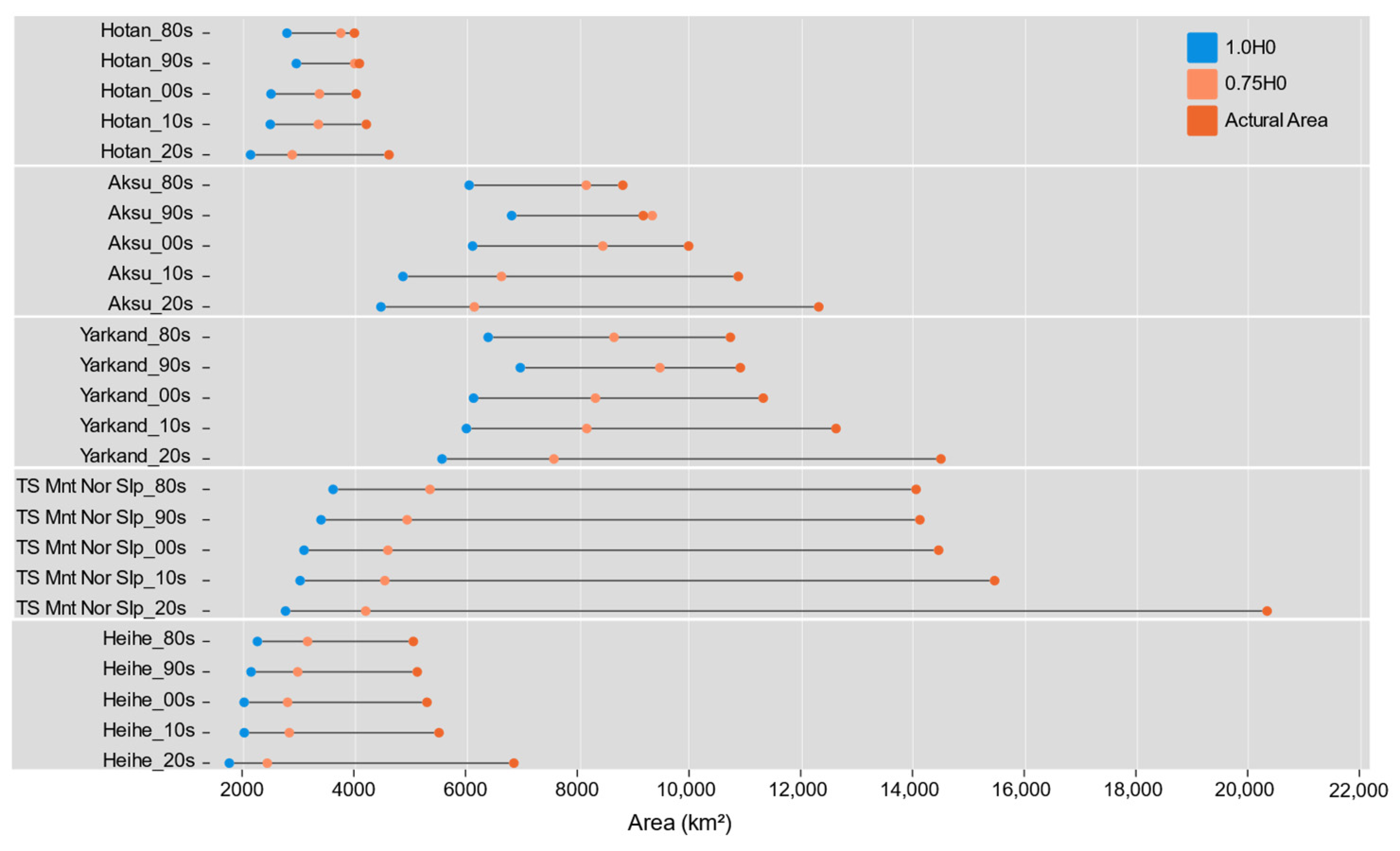
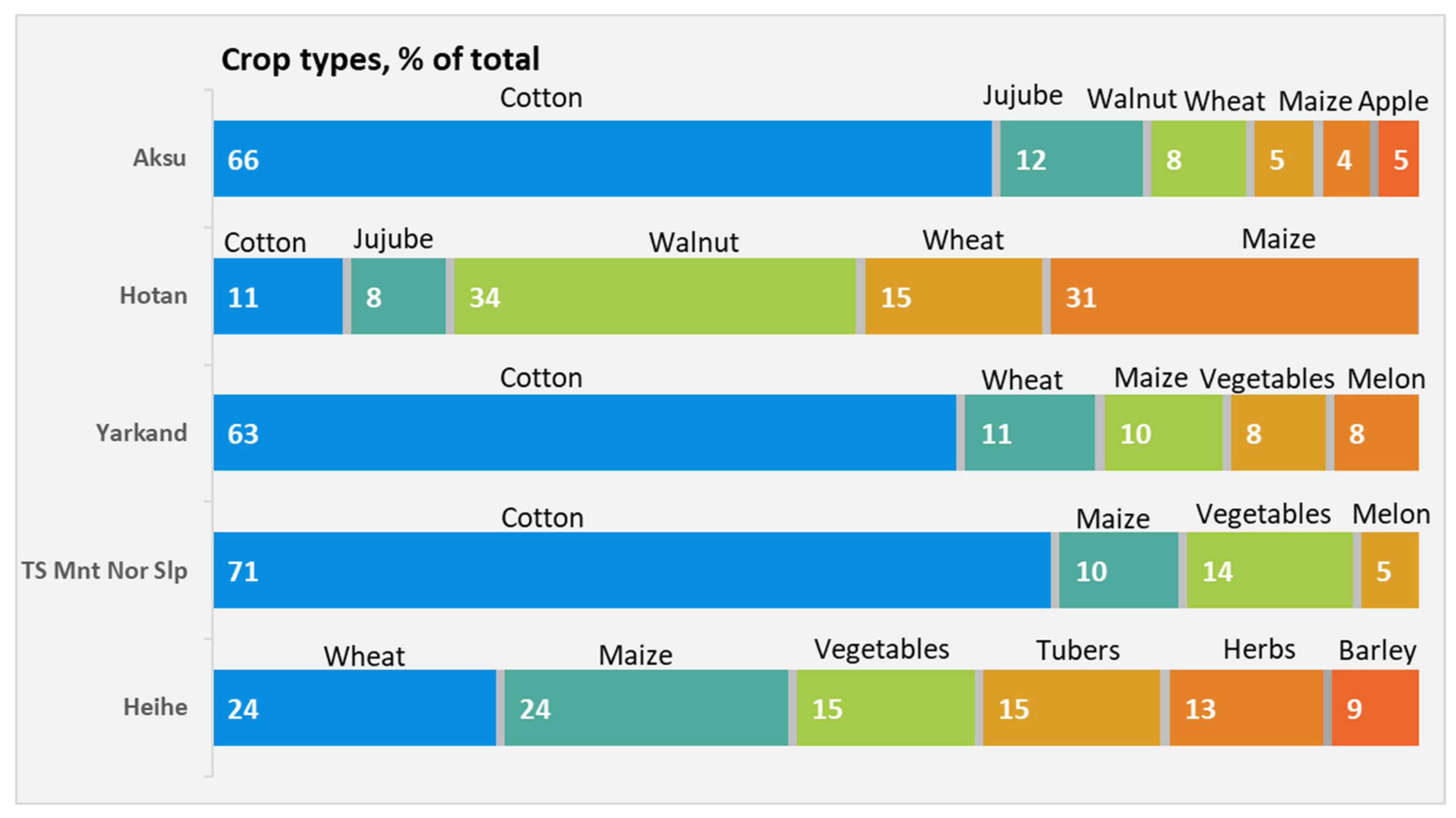
| Items | Aksu River Oasis Group (AKO) | Hotan River Oasis Group (HTO) | Yarkand River Oasis Group (YKO) | Tianshan Mountain Northern Slope Rivers Oasis Group (TMNO) | Heihe River Oasis Group (HHO) |
|---|---|---|---|---|---|
| Area (km2) | 12,293.65 | 4599.86 | 14,480.20 | 20,320.31 | 6836.77 |
| Farmland area (km2) | 9241.69 | 3024.90 | 10,693.64 | 13,988.53 | 4302.85 |
| Available runoff volume (×108 m3) | 53.42 | 30.27 | 64.75 | 39.00 | 20.93 |
| Urban and Industrial water use (×108 m3) | 1.97 | 2.418 | 1.80 | 16.73 | 1.41 |
| Precipitation (mm) | 103.86 | 51.58 | 68.60 | 300.93 | 137.09 |
| Potential evapotranspiration (mm) | 1258.02 | 1363.14 | 1202.79 | 1110.72 | 1257.25 |
| H0 | Type | Evaluation of Oasis Stability |
|---|---|---|
| >1.00 | Extremely stable | Oasis area has potential for expansion |
| 0.70–1.00 | Stable | Oasis area can be prudently expanded with reliable measures |
| 0.50–0.70 | Metastable | Oasis requires a high level of investment to remain stable |
| <0.50 | Unstable | Oasis must be reduced in size to maintain local stability |
| Farmland Area (km2) | Oasis Area (km2) | Agricultural Water Consumption (×108 m3) | Residual Water Resources (×108 m3) | |
|---|---|---|---|---|
| Aksu | 4608.83 | 6127.81 | 22 | 29.45 |
| Hotan | 1882.6 | 2869.02 | 8.8 | 19.1 |
| Yarkand | 5579.17 | 7552.81 | 24 | 38.91 |
| Tianshan Mnt | 2880.6 | 4184.56 | 11 | 11.19 |
| Heihe | 1524.27 | 2421.89 | 6.8 | 12.63 |
Publisher’s Note: MDPI stays neutral with regard to jurisdictional claims in published maps and institutional affiliations. |
© 2022 by the authors. Licensee MDPI, Basel, Switzerland. This article is an open access article distributed under the terms and conditions of the Creative Commons Attribution (CC BY) license (https://creativecommons.org/licenses/by/4.0/).
Share and Cite
Li, B.; Gui, D.; Xue, D.; Liu, Y.; Ahmed, Z.; Lei, J. Analysis of the Expansion Characteristics and Carrying Capacity of Oasis Farmland in Northwestern China in Recent 40 Years. Agronomy 2022, 12, 2448. https://doi.org/10.3390/agronomy12102448
Li B, Gui D, Xue D, Liu Y, Ahmed Z, Lei J. Analysis of the Expansion Characteristics and Carrying Capacity of Oasis Farmland in Northwestern China in Recent 40 Years. Agronomy. 2022; 12(10):2448. https://doi.org/10.3390/agronomy12102448
Chicago/Turabian StyleLi, Bofei, Dongwei Gui, Dongping Xue, Yunfei Liu, Zeeshan Ahmed, and Jiaqiang Lei. 2022. "Analysis of the Expansion Characteristics and Carrying Capacity of Oasis Farmland in Northwestern China in Recent 40 Years" Agronomy 12, no. 10: 2448. https://doi.org/10.3390/agronomy12102448
APA StyleLi, B., Gui, D., Xue, D., Liu, Y., Ahmed, Z., & Lei, J. (2022). Analysis of the Expansion Characteristics and Carrying Capacity of Oasis Farmland in Northwestern China in Recent 40 Years. Agronomy, 12(10), 2448. https://doi.org/10.3390/agronomy12102448







